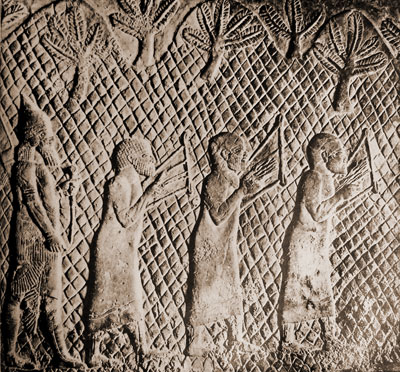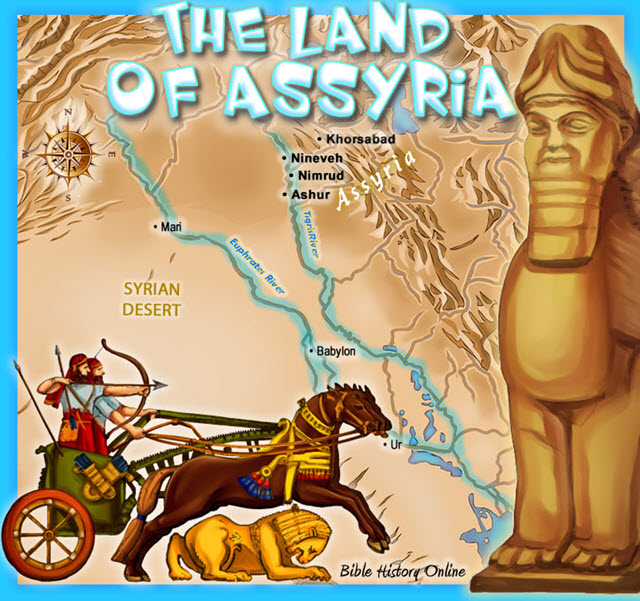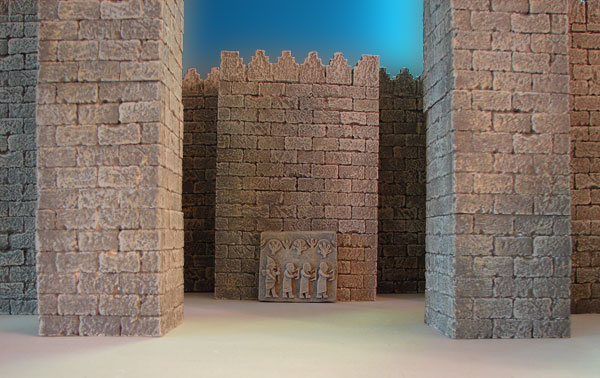|
|
|
 |
The Bible
Mentions Jewish Captives were Forced to Play a Song .
This miniature relief shows an Assyrian soldier forcing 3
captives to play the Lyre while they were being led into
captivity. The Bible mentions
this in Psalm 137:3 |
This miniature replica shows three
prisoners of war playing the lyre while they are being led into
captivity. The limestone relief is from the Palace of Sennacherib, king
of Assyria at Nineveh his capital. It is from the seventh century
BC. The original is located at the
British Museum.
"They that carried us away captive required of us a
song" - Psalm 137:3

This map shows the primary capitals of the Neo-Assyrian Empire
Museum Images


Information about the Three Captives
Playing the Lyre Relief
- Alabaster relief from the palace of
Sennacherib at Nineveh, his capital.
- Three captives (possibly Hebrew) are playing instruments, the lyre.
- The archaeologist who excavated the relief believed them to be Hebrews
- The Assyrian soldier is forcing a song, carrying a club and a quiver.
- It was common for Assyrians to require songs from captives.
- The captives are barefoot, wearing tunics, 2 are wearing head
coverings with headbands.
- The lozenged background shows that it was in a wooded area or forest.
- The detailed relief stands 99 cm (3.24 feet) tall.
- Sennacherib reigned from 705-681 BC.
- The 10 northern tribes of Israel had already been taken captive to
Assyria (722 BC)
- Sennacherib's west campaigns extended to the land of Judah
- This could have been a city in Israel or Judah but it is uncertain
- The event took place during Sennacherib's reign.
- This wall panel is from the Neo-Assyrian Period (1000-612 BC).
- Excavated at the site of ancient Nineveh (Kuyunjik).
- His army was defeated at the gates of Jerusalem by the Angel of the
Lord
- Ancient Nineveh was excavated by Austen Henry Layard of Britain around
1849.
- This stone panel is currently at the British Museum.
- Nineveh (Kuyunjik) was Sennacherib's capital city (Northern Iraq).
- There is no certain evidence that these three were Hebrew, but
definitely Semitic
Note from Scholar of Assyrian Artifacts:
"The employment of captives as musicians is interesting, though we
cannot say that the captives are Jews. It shows us that the Assyrians,
like the later Babylonians, were in the habit of "requiring" music from
their prisoners, who, when transported into a "strange land," had to
entertain their masters with their native melodies." - Henry Rawlinson
"They that carried us away captive required of us a
song" - Psalm 137:3
Note from Biblical Scholar
"The kinnor was probably the Hebrew form of the Lyre, and this
view is strengthened by an examination of the interesting relief showing
an Assyrian warrior guarding three Semitic captives, playing on Lyres
held obliquely. The dress seems to indicate that they were Israelitish
prisoners...the instruments on this relief like the Lyres of the Jewish
coins, seem to have four of five strings." - Encyclopaedia Biblica

Museum Excerpt
Museum number ME 124947
Stone relief from the South-West Palace of
Sennacherib
Nineveh, northern Iraq
Neo-Assyrian, about 704-681 BC
Prisoners, probably from Phoenicia or Palestine, playing lyres
This is one small surviving fragment from a much larger composition. The
scale effect on the background represents rough ground.
The musicians are often thought to have come from the state of Judah,
though there is no evidence for this. The style of their dress is
different to that worn by the people of Lachish (see for example, a
panel showing the siege of Lachish). They are, however, almost certainly
Western or Levantine in origin.
Music was clearly an important part of court life and Assyrian kings
often refer to taking musicians into captivity as part of the
deportation of defeated peoples. There is evidence of music in religious
practice at an earlier period, but reliefs like this provide the first
images of musical instruments in an ancient Near Eastern society that
are not connected with a religious ceremony.
The musicians are playing lyres. They hold them more or less
horizontally and use a plectrum. This type of lyre was possibly
introduced into Assyria from the West in the first half of the second
millennium BC. Only a few are known and the chronology and
classification of the many forms of lyre in the Near East in the first
millennium is neither complete nor certain.
Dimensions
Length: 99.060 cm
Width: 101.600 cm
The palace was excavated by A.H. Layard (1846-51) and by many later
archaeologists
British Museum Page
 The Assyrian
Empire The Assyrian
Empire
The first great military empire in ancient history
was the Assyrian Empire. By the time of Ashurnasirpal and Shalmaneser
III in the 9th century BC the Assyrians organized a mighty army of
nearly 200,000 soldiers. Their military strategy was unsurpassed up to
that time, and with the age of iron they were an unstoppable fighting
machine. They brought spearmen, archers, shieldmen, slingers, siege
engines, chariots, and a huge calvary into the battlefield. The mighty
Assyrians dominated the ancient world until they were crippled by the
God of Israel in the reign of Sennacherib. God raised up the Assyrians
to remove Israel out of his sight for their rebellion and idolatry, but
the Assyrians would also be punished also for their wicked ways. They
finally fell to the Medes and Babylonians in 612 BC and passed into
history.
 Assyrian Kings Mentioned in the Bible
Assyrian Kings Mentioned in the Bible
2 Kings 15:29 -
In the days of Pekah king of Israel, Tiglath
Pileser king
of Assyria came and took Ijon, Abel Beth Maacah, Janoah, Kedesh, Hazor,
Gilead, and Galilee, all the land of Naphtali; and he carried them
captive to Assyria.
2 Kings 15:19 - Pul the
king of Assyria came against the land, and Menahem gave Pul one thousand
talents of silver, that his hand might be with him to confirm the
kingdom in his hand.
2 Kings 18:9 -
And it came to pass in the fourth year of king Hezekiah, which [was] the
seventh year of Hoshea son of Elah king of Israel, that Shalmaneser king
of Assyria came up against Samaria, and besieged it.
Isaiah 20:1 -
In the year that Tartan came unto Ashdod, when Sargon the
king of Assyria sent him,) and fought against Ashdod, and took it;
2 Kings 19:16 -
LORD, bow down thine ear, and hear: open, LORD, thine eyes, and see: and
hear the words of Sennacherib,
which hath sent him to reproach the living God.
2 Kings 19:37 -
And it came to pass, as he was worshipping in the house of Nisroch his
god, that Adrammelech and Sharezer his sons smote him with the sword:
and they escaped into the land of Armenia. And Esarhaddon his
son reigned in his stead.
Ezra 4:10 - and the rest
of the nations whom the great and noble Asnapper brought
over, and set in the city of Samaria, and in the rest of the country
beyond the River, and so forth, wrote.
Assyrian Kings Names in Cuneiform
Archaeology
of Ancient Assyria
Timeline of Ancient Assyrian Kings
(During the Period of the Biblical Kings)
Assur-nasirpal II (885-860
B.C.) A cruel warrior king, he made Assyria into the most fierce
fighting machine of ancient world.
Shalmaneser III (860-825
B.C.) His reign was marked by almost constant war. He was the first
Assyrian king to come into conflict with Israel. King Ahab fought
against him, and king Jehu paid him tribute in 841 BC. His royal
inscriptions were more detailed and more numerous than any other king.
His building works were massive just like his father Assurnasirpal II.
See Shalmaneser
and the Black Obelisk.
Shamsi-Adad V (825-808
B.C.) Most of his reign was focused on Babylonia and his own internal
conflicts.
Adad-nirari III (808-783
B.C.) The little information about his reign mentions his building
projects at Calah and Nineveh, as well as a conflict at Der in Babylonia
and collecting tribute in Damascus, Syria.
Shalmaneser IV (783-771
B.C.) The limited knowledge of his reign reveal some conflicts in
Damascus and a period of decline in Assyria.
Assur-dayan III (771-753
B.C.) The little information about this ruler reveals Assyria being in a
period of decline.
Assur-nirari V (753-747
B.C.) There is very little information about his reign. The king of
Urartu boasted of a victory over this king of Assyria in an inscription.
Tiglath-pileser III (Pul)
(747-727 B.C.) He restored Assyria to a major world power. He is the "Pul"
mentioned in the Bible and the one who began to destroy Samaria, the
capital of the Northern Kingdom of Israel. He carried many away into
captivity. This captivity is mentioned in his own inscriptions, the
Babylonian Chronicle, and the Bible.
Shalmaneser V (727-722
B.C.) He besieged Samaria, the capital of the Northern Kingdom of
Israel. He died during the siege after imposing taxation on the holy
city (Asshur), and his son Sargon came to power.
Sargon II (722-705
B.C.) He completed the destruction of Samaria and the captivity of
Israel. He was also famous for his magnificent palace with his colossal
winged guardians.
Sennacherib (705-681
B.C.) He was the most famous of the Assyrian kings. He mentions the name
of Hezekiah on his prism during his war campaigns, he claimed to have
"Hezekiah captured in his own royal city (Jerusalem) like a caged bird."
His army was defeated at the gates of Jerusalem by the Angel of the
Lord. Sennacherib returned back to Nineveh and was killed violently by
his own son, as mentioned in the Babylonian Chronicle, The Bible, and
various other inscriptions. He also conquered Babylon.
Esar-haddon (681-668
B.C.) He rebuilt Babylon, invaded and conquered Egypt by crossing over
the Sinai Desert with Arab camels carrying water for his army, and was
one of Assyria's greatest kings. He died fighting Egypt.
Assur-banipal (668-626
B.C.) He destroyed the Thebes in Egypt and collected a great library,
innumerable clay tablets were found.
Assur-etil-ilani (626-607
B.C.) It was under his reign that the Assyrian Empire fell.
 Assyrian
annals mention contacts with some ten Hebrew kings: Omri, Ahab, Jehu,
Menahem, Hoshea, Pekah, Uzziah, Ahaz, Hezekiah, and Manasseh. Assyrian
annals mention contacts with some ten Hebrew kings: Omri, Ahab, Jehu,
Menahem, Hoshea, Pekah, Uzziah, Ahaz, Hezekiah, and Manasseh.
In the reign of Hoshea, king of Israel, Shalmaneser, king of
Assyria, twice invaded (2 Kings 17:3,5) the kingdom that remained, and
his successor Sargon II took Samaria in 722 BC, carrying away 27,290 of
the population as he tells in his Khorsabad Annals. Later Assyrian
kings, particularly Esarhaddon (681 BC - 668 BC), completed the task.
For More Info See:
Bible History Online
Map of the Land of Assyria

Kids Bible Maps
Primary Sources for Assyrian History
The Assyrian Annals. The scribes of the chief cities of the
Assyrians wrote the accounts of the king's military campaigns on
cuneiform tablets, and clay prisms or cylinders. The accounts are very
reliable, even though the accounts do not speak negatively of the
Assyrians and are meant to glorify the king. The annals also give much
detail to geography and Chronology. It is interesting how accurate the
Assyrians were with dates, they made use of an Assyrian Kings List or
the Eponym Canon.
The Assyrian Chronicles and Eponym Canon. The Assyrian scribes
organized their national events whether military, political or religious
every regnal year. The Babylonian Chronicles were structured the same
way. Assyrian records were kept very carefully, they took their dating
and their history seriously. They attached their record of events with
the solar year and with the name of an official who was known as the "limmu."
Their was a new limmu appointed every year. They recorded military,
political and religious events in every year and made references to
eclipses. The Assyrian records are highly dependable and allow Biblical
scholars a very accurate way of dating events and designating "eponyms"
for 244 year in Hebrew history, from 892-648 BC.
The Assyrian King List.
The Assyrian King List reveals a list of the kings of ancient
Assyria in chronological order, from the 2nd millennium BC to 609 BC. It
lists the name of the king, his father's name, the length of his reign,
and some great achievements.
Assyrian Sculptures. The limestone bas-reliefs discovered
from the palace walls of major Assyrian capital cities like Nineveh (Kuyunjik),
Nimrud (Calah), Khorsabad (Dur-Sharrukin), and the bronze bands on the
Balawat Gates reveal a wealth of history. The illustrative events were
carved be professional Assyrian artists like a modern day photographer
on the scene. The carvings reveal the military might and tactics of the
Assyrians, as well as the futility of those nations that defied their
might. These sculptures are on display in museums around the world, for
example: The British Museum in London, The Louvre in France, The Iraqi
Museum, and The Oriental Institute in Chicago.
The Bible. The Old Testament records the history of the Kingdoms
of Israel and Judah, along with the battles of other nations. It
includes the fall of the 10 tribes in northern kingdom of Israel in 722
BC by the Assyrians, as well as the
fall of the southern kingdom of Judah in 586 BC by Nebuchadnezzar of
Babylon. The Bible also records miraculous events surrounding people
like Elijah, and Jonah, as well as the slaying of 185,000 Assyrians at
Jerusalem by the Angel of the LORD. The events recorded in 2 Kings
generally agree with Assyrian and Babylonian sources. |






